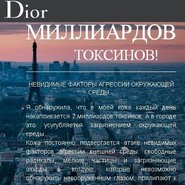Of the 55 percent of luxury brands that offer Russian Web sites only 14 percent of brands offer Web sites with advanced Russian translation, according to a new report from L2 Think Tank.
The Digital IQ Index: Russia Prestige found that many luxury marketers are not providing translated content for these consumers via digital media. Even though luxury brands have a global presence, it is important to also provide local and language-familiar content to consumers around the world.
"In Russia, leading global brands consistently underinvest in language optimization, prove absence from local social platforms, and copy Western mobile investments despite a different device mix found on the ground, all of which significantly handicaps the majority of prestige brands examined," said Leeza Kuznetsova, research lead at L2 Think Tank, New York.
"Only 15 percent of the brands examined are currently shipping products internationally to Russia and only 26 percent including 10 hotel brands are engaged in direct ecommerce," she said.
"Aside from translating rich media assets, brand collateral and lifestyle content on site and social media properties, brands should adapt to shipping and payment options familiar to Russian consumers such as courier delivery and cash-at-the-door payment."
The Digital IQ Index: Russia Prestige analyzed the digital performance of 84 global and local prestige brands in Russia. The brands were ranked 30 percent on Web site effectiveness, 20 percent on digital marketing, 20 percent on mobile and 30 percent on social media.
Language barrier
Russia is Europe’s largest Internet market, but only five percent of the population is proficient in English. Even though there is a potential for growth in the Russian market, luxury brands are failing to effectively communicate with consumers.
With 77.5 million Internet users, luxury brands should focus more resources into communicating with Russian consumers.
In 2012, Russians spent $8.6 billion on luxury goods and $12 billion through domestic ecommerce.
Out of the 84 brands surveyed in the study, Estée Lauder, Dolce & Gabbana and Giorgio Armani were the luxury brands that made the top ten.
These brands engaged Russian consumers through Cyrillic translations, substantial social media presence and ecommerce.
Brands that did not fare well among Russian consumers were those that were inactive on local social media platforms, those that lacked a Cyrillic Web site and were not compatible with Russian consumer devices.
Furthermore, even with 82 percent of the population active in social networks most luxury brands do not actively pursue Russian consumers through direct communication.
Fifty percent of branded videos examined for the study were not translated into Russia. While some brands added subtitles, only 11 percent of social videos featured Russian voice overs.
Chanel and Dior were of the five brands with social videos with Russian voice overs.

Chanel's Russian Web site
Dior’s campaign for its new skin care serum One Essential featured educational information and a video series with Russian voiceovers. An emailed newsletter was also modified for Russian-language consumers.
Brands with a strong following on Russian social media platform VK likely saw more success in the market.
With 44 million users, VK’s top ten luxury brands included Dolce & Gabbana, Chanel, Givenchy and Dior.
Facebook, with 12.8 million Russian users, featured Ritz-Carlton, Estée Lauder and Keihl’s among the top ten luxury brands with an active social presence.
A strong social presence is important in the Russian market.
"Brands should also be aware of where and how Russian consumers are searching for them," Ms. Kuznetsova said.
"Fourty percent of the search volume for brand terms across Yandex and Google was in Cyrillic script, as opposed to Latin," she said. "Brands should also prioritize social media investment on VK, which attracts three times larger an audience than Facebook in Russia, with 44 million unique monthly users.
"Brands that operate directly in Russia, as opposed to operating through a franchise partner, perform the best in digital."
More mcommerce
Luxury marketers in Russia should consider mobile commerce as a viable platform to reach additional consumers.
The L2 study found that 27 percent of brands lacked a mobile site while only 21 percent were available in Russian. The majority of mobile sites were available only in English.
Gucci, Dior, Hugo Boss, Donna Karan, Tiffany & Co., Chanel and Jaeger-LeCoultre were among the brands with the top mobile applications for iPhones.
Only Chanel’s app was available in Russian, despite it lacking mcommerce. The app features a Chanel store locator, runway videos and Chanel’s news blog.
Google Andriod also offered Russian consumers mobile apps with Ritz-Carlton, Dolce & Gabbana, Omega, TAG Heuer and Armani being among the top rated. Of these five apps, none were Russian optimized.
Adapting global sites to for local consumers will benefit brand's seeking to expand exposure in the Russian market.
"Early ownership of regional efforts grants select brands, such as Chanel, Dior, Louis Vuitton, and Montblanc, a head-start on Russian ecommerce and greater aptitude in digital communications tailored to local users," Ms. Kuznetsova said.
"As brands debate whether to exit their franchise contracts, they will need to play catch-up with these first movers."
Having a local site may also help prevent counterfeit goods from saturating the market.
"Estimates suggest that up to 30 percent of goods sold in Russia in major retail sectors, such as apparel and cosmetics, are counterfeit," Ms. Kuznetsova said. "Without a direct presence, brands that operate from the periphery face increased competition from unofficial channels.
"During the course of the study, we came across many fake ecommerce sites and VK stores, some more convincing than others."
Final Take
Jen King, editorial assistant on Luxury Daily, New York
{"ct":"6j7ve5zNgcd0HQ3GX1Ub9+y0Si3bDTyFiPgJq+xtIngUnQaPFh8WGqrZH8NAsjUNZwysC5Fg9w4S3l5ZghXGdHo40+JW0SibVL95YYfh2f+UBzx4n6VvaJ+DMXrgRWXO7GxuY2M+J4Lv+JN4QE8gsJE2MaGZX0XTcjpGw0RCk6oH\/WPWUoT9ptGUewjQ3xajlQRPDyNI3hrBsXwqGbM6akqUXHieu4TBWzBEqHSEWC2XA3xJfZb6J7iEFK2tv\/xmJyZAircAZnShvEIRGiDPJ0E7UBdLLmgNqcLQSQXFRrczEGTiegZiGXQA3rmAvaDEQT+P8Dd\/JgvpNCZDcSgvtb53lT88GZZE33lpwbv0JVpoWbmg+NfhwS6RwaWF+vR+jfxwM4S1ozd\/2Ox9MoDx60HH8aAHkGfrMkaREHy9ApwDAJ1B\/fLEkFD1cxEWcPe1ay\/ELRhaN8B3glxzSE3OeIXNjf+KfqanGQH\/\/zQE6AJKAWSZLRq4VCkHFE35sEXziSAq8uvQyznOOfxUtXRl3XieUv8xk7WeStVmbTi2IUn7lN8qQjTc+cfT1bU16cqTVmBgO74M7\/K3BE\/ZugBP1IFQDdT\/Q2+wlgsSrCGIiPP3AXgPaXL\/Ft+7JlPCeOPucbHyajf8bNcoU9Yv3fGnhNenyQ+0u0yM0P2pcyr5WHb7nUnYWDzk7JSRli0MU9GqFlf1ayKU8yjOcp6PUxrhBc17NZc0JFLs\/8IiJubMttiW5\/QWhEzEaDkCn8YLcrbtQrPqu6vtj\/9FreFs67oMG60lzL4VwNQJFVOhe1fyNawXdH6ZdGZLZkamkEITQ0kktHaHCG6GxwjplzMQ8oV2VvXP3\/bpxq8lci7wdFxv7PsJryI5wJva6KWA+sF5ONS7XgPZ8Whq8GieQchm4co6xFn0+gz0rFYOrdGc3F99ctb2tvBmw1Lg6SJ1M9uZ9dRjSvZhsTcTidRs2wX5TH4udGplk0xpJS+WNNM4SUMyRqDoy5zu05D23ays6s51QF3MPtGp2YIWjuQEu78knAUP7WTgqFDPTuvWSox3t41Obha+\/Knqa1PK8TblO+kjB\/wOXYu+8\/UF65YUoInKNXTA7eVk0C8+vrmQlDlrSAcuBTuZhV5OmrpTh3GQLCpUbq+5Eoj9Or4xuDbOdc3MNQFjFLUv7apXeF7dd1JgphLO+6dQEznz\/FipNOdfGUrlcWqqb0n+O1YunBUqbXk4dhZJh5+cV2wmdx4Va2KJPEHNzbftGHAD5y+wlIo1l4jPCkj7jvX5BAbwz\/LpguRmGjWsW3ta85+PpArkyfx8KLe5iqHf8knBwEZ5oGJz8s6R6jWa5G7P6JljNQOJIU\/XqHM\/SVtnGD5Q5VvOJsp3l9xyMeYAP2A0knt9WNfc9JqDs\/ryXShi2jZCH2jKyPk7i6QFNfQnu5H66PiosfTpl\/wTLK6YhQh2hN0mG8KhJAdz7i5IATA\/ObbAmunfOcfni2ekTRBgcfuhR0g515FRvfL0Zg8coZMdZmHjGl+a5NDbtidR7S0U\/fO+GI92ieOAIy57KyXayZRurKbvaddeJxXP01XahfunpGWrKiXXPJ7t2MPeTJkYKunRsVxXcQZpNvN3i75Ct+mxkrmkcF+pcuD\/QKCjH80ABo4uu0OD2ScDHaDWuAjHLkeUnSGWiC5YbY0dZnIwCKy6g3VgQ9yBw2rJhtHcwsPqckRTWylygggBjrHHKswE0JSUQiY6X85Zb2I\/a1AGFuIlu3gxzhdrujM4WxfxtENIpwVuqwWCxW6uK0gMBtzYDsItZPTnEFcEpuLLMwbkpeIHPg5PBX8dnjl+jotmjwGCChTYCurz9pIYzhzTl2Am6aLG0n0oiieap5pPHvwVe+SZpax04AffOe3zL22tE0nmVLXtwR6Yf\/Zu8aFRPLYi7ArVJ2jhi5k2olJO7o6rKN7rUEvTHebGSrtZwf438toi+4mCQPLQOkp9jFgXSC1NE3HfAeAasFzndmfX03lXufREPYmJbCrNTtyPgvNxSsMhZRQewd2YOA+RAPm9ayYf\/015EFYbXAl5MwY9kx+U+r9Wvu2WOwgjq1Qz+ju62pgD7UXpm6ldiYs40F6oDPya\/taLfhlO7NgH9PSNQ9Qe5hXNEOxjF\/KqRXlAnt5Ga\/KbFK0l7rcsDolBdGoxQf7tlcXxYWwSg9C76gpIXkuMayotgzZralBFTQvBBwnNVG0mZNfhnlsXuOYV9717gdp8slzG\/tItYYZ8wLbBpjXu0xbRJApwYXdT6u8a+o+uLw87VKEHVexqkXneutWL9hy6Kxs+wn4C39V8xn7HE3Bbu2B6EnARSiyAOKUMH0kyXpZBbfhI\/gjRpMbou84Yz35jo\/8ko4XEDk9\/Gn5Idru1rCobhcqr2hOWoW5+XQJT3UCx\/4Qzzp1E8Z38vsAG63Cpgz9T5XfivlLSPVgRBoMR4X1H3k+lPMOgrGsSKtn11PnLeUDqHsV8LQELyMZk9+55Ex+OSaq5oAGvvxavMkIHo5E7qh8DJ4v\/ph3uAdTM6hHRy4jVYQDo4j2ljheiq8kRk4SlO1DjI\/1qErF7Z+T\/JZPn+BmuUr6hNHb4J2MOPojpx0QFvyEuI1YMnX\/MIUCQ3XImhy0+UaCu3eG2vN42SFKTOIrbdiIPt6zQnDdtknw9+8h5jlYI\/P3CIPwTclbMCpSdNRula1a7aOThyljVmWMriCNwJtEQxxrx5j8LKYlHhNlYiz\/0YMiWJaGkkJxYqbcQBaAKQyPPafXj+PKBE7wemSD\/8mqhBY6eJLMgvZderRlyuf0qW4+19+zrLauofuZJqpxZlJDOb5Pb\/386zklsYu1gPGazSoshPqAGe3TsQSCkg81KeDYgRqkt1NdTLMErv2LCbaDZj7Yd22KXDKNrkuDWGrNWFKHfmmbb2h8gZkKOJQKbzSNnKK6R02iVR4NMLcOBl6jg6me+2TzIxa6eju5LqWA30uclKqgF2t2Azt62gYhEoeMe7D6iaR4vEgpuLQOn0ZqDQBuS95gBWeKCiTztVV0vRPVxBUDV84Byqs\/d2sDtGsXcqOaxrIAPfaHkFK6hds9FmfCHcR1\/FJqpjC8emM8sqz0hf9i6oXrVwQ+KKas8zukASXjiL7zdWXEaiRqXcnijtTKfHx1h2Q40Em\/cKv+OtVRPTvXduusBGB0FMw0Obri6ha4ChoED2t30u7hhkxo8kX6sn5eaw5x7I8RbldDuade0DU4M5t2JO6dPHQeBrmlLe4Ex8yLNq5WGESW8pFu5UUGyad1FiborGyeiknkdlUcOfJdAH4gtQAxk8jUOuK2XtwThf3mdoUTeAuMqSFw9zEkyNAbGtU41EPEwghkgo7fgxQxxFGs3FrS4OKh5fM7llp2hsr+MJGg+eQWEs\/ovM3o0cBcDgnsfVqQxI893dHr7oMuopTaZlkF6mNP9yz12SSTpMe\/cW13+8ox49qKrTUUPWqjJugIJek\/1RjUUTeKAZM7hh2ASrQrP4T+IzB0KF6VOse4fHfsGLPuRNGFnC4VbRdyg\/weu8QQYhaLzcwVIKqvWp90MobRXIqGFVsyWrtDYQYYebr2JXKCA4IlVQF6Tnmd28c+wyJ\/tVrL+6OPmmGpyZJbi48Lol2g1+M83xJ1duRJnLBtHeuxb8pKt2f83d7SrRBTtoRW85TdWWJh23bXM4ISpmX1E50xgyel6ZdnmSs49FsZ4\/L2Q06WkvsBTNIvO6pL1a2OGIOXnUhTJez6uk9ZmN8xAYyDXSp9P\/APTM7\/z2kSoZOLNunqcw5WzFDbhy4gasjyL3\/UmjzqKuSK4uotSN6YFFOObc7sjIuM9pCXvgeHZFgZaMiopDA7yZygKu7izv1jVAi5BDCuDPqht+FlDhoIWviqkY1foLsWggJM830osmKNRAT0P4DHAFrAgeBYRi9bwWjtR6suEomQmtkhFRsoGcXdHl5GlNsIHI3vxOUeCAtTZROFIel470hCBjJizSDYzLPeLfMClwUMhnbPaVGFRtE02E3BnpdFaIBe4tZjxbuVlcnCbv4mCkiNAXvmuqJhxwWLg8EFYszOrJ+ifSUlw8uqUhrFowqYSeRZn3f1tB0HN9\/5hnjhi5zaSq4egSlZqZnPUSyI1TZgScCkDSvbGIxAx2ES4tLGZfaj0cppWyyVogDo13qLJNcH0O7EfnfFm5ieDTKXulYiVAUcnMS7Wd+zGQnrrERJUlDhu0hXHE1wRwbOFxN4r\/H9nBRwvtnwHfvTCGBbvN+GvneVNR3DuCvZuwUy5kK1PwAK0Mf8DwIsrezOMqakRRUlCPeldCMRnE0cJiqHYYngnSfnAbcHTfhYAUBddqpmwBjrecGzU9KsfXhdsLlIxaMrCWOiF5FgmfI3J9YlEvI5Irg1gh\/lY++UcnKBEY3WYU5cGgQTEfeXfZque\/iSy2GlvA\/Ut0CzbFg5oeLYadFwsFJSQ4xIFtGdHjcKoQA9FomPi+jWWirswq\/rbuR12KzJBCyHMRm84QFs7w30RKVc9MWSwpclMESt\/J+MLtxvxtjaXIS+RTd1OkuzBH9jzLsubs3oY1wGTPmXhxB9b06cTwaKum1ADiVNqqzrSpo4yqCwGWSohC8ADx8k\/21MGogwGUb1tepn3S3z2oFfnl5Ot1t24CEwEIFbW89lNxnpp\/mVNnKbE\/h5zhK7CEGcsifE91HjB2QItm9nEi1B5GQBOpUxuBSziKVEfpu5Z03lzeDjuHfakUKy2BTri\/qzsxbi2cRV6prOh\/GxSsPMW36aT4tGdunDM96\/xFvywrnRvD522bRti08qi9Ohgm3aH14QlFWb60IoJAuVMXBX\/ceHPuytkhqqm840Vbpf\/0z65j40h9WVR8\/mnkdme3y0aRIbNrijiTuzYtZElWPJsKJpKnbv3nPY0u\/++QKrvq1Ilc61AaWh5UTul7bmKaLTt5E85qHH8W3utWEFmc5YMs19xdktuP9ZHJlf5Jqyw7s43p2IsbLpZtxzpgTfn7NW5\/Y8eVLL2tS+baOEI5tdXXKRHH1PuKKvBmuz+joMYJ+IaoyP25YhLmXA4LqSJTEMbTAdvu9ygbCkEAexE10eiAcMfN\/szQK10nsPcayjIHcFBHM5zB\/XzMl9fcAdHosC3KLP5O8jp21SKp1jweyVkWKpaGsBEw+I6emzMezTyxjDJla5UeQUMGu3qwYUAgtg0opcZ\/yAnb+JKgJCxV2+UaSZoajpQSceJ8RnhR1nvCjZDakNMeReN9znaWaxQfVpu29VSY4nZV+u32uBU3YdEmYMUBaHRGtS3nbrTDwx82NLCLo17YQL9BiSAtUVfSvnUia1A77zD174LOMPvKC57iwVS1TRKgmUjPte9liFytZYYnTi3OlVJY\/qZ8q4s00DNSx2j\/9MzPBjAx\/HDnsJ1iXm98713oyfSNhzQfv8vYAyuUKLyffyvm0YVPbMnfxZVxglr38zGyyoouXbrtcdHtr00n2QAfbEJrBFN6ZGeqo\/WSvN9fZll8Syqgjkg2WdKTjf3t2uipNyWQBF0\/97Fkd8n5+NOq1KZqfRmdlgt1uokp+087gw5U7JhpDEuPtvpeextFtRPeLwNlMdcKlzC\/EFtiMnoll1BziERGvdvYD2ySRvbKVV3hhPCzKmZXNy6l1euPGFSkdfdlipuMzw97BATXVh0vzM4DqgcsLRLHv6j4RBnV2o2Qjz0dALVIlzTnnVkrl\/ICse3SOWdVm+C7mK5T3ip5rsxxbpUD8yzBC+A9e\/o+c3XQFsPoNEApkYmgFkamyYs8EDgXfniCEogMX0n3u3TolpUjZJuDgbmRvaQ4nbjNOjiA3sumI65dVa9mChjU++vbqyFRQOjEckBkKxMJgdQgqdfGetbqTPxZNM6LVTnLOySNBHkcD2jhQEBboTLs36NMboo2u4Yt92S\/P5ibbX2SHXiGOzgCXVPEx0g\/Z3nuI37PeLLWjLujHfZi1\/VXiaoDvpCtOVHMEkiX9GrUHafUvGlYSY2qlAcjbLwpBPOXM83IvrA1L\/\/0X+3EX1c2PD8Pow+Xon0o9ZU61LQIxangf7gNRzG6VMXXSea5dXfBXj9vNKbdrbEuXFfeRZ5nVU9SO\/zvwpZX7ky5eZblj\/7Kp\/euHTrJ17L46TGjGSL42x5mJmIPfW3nKEwVW4m6WvyCQYgeMDOFClv6pqMrXCNCB0IFTwqBgd6mfLznWddijMPZjtmXhTffd\/3SN7idqq1m2ced0q6i9VIAOXzgg\/0kUw\/NbQH+3LFplRqXO8MQ0REwvIVKWAjB102p0JI9W\/qfgW1aXsoo\/4\/ydozEsaH2EL+heUCSyNISZUdDdX3AUZ20+W9+SkZQNkSqo8JIypcqLgVlsWM6WTqR4JKxzmEUxuz4ykPlO+UUDhKJe8FEFBDzG4\/3M2uF1IABOBJjR+lSKo+vNM5AcDO6Q6akQeG2FDC9kPPTa+gWgEwiX9\/wrK0yosCVRdMQoXZGYmdl76BUnsIEsnk\/kEOVH25NCeKFIQlCOimE4nlrnQYZY2Iopn3Nmzb2g8xHjGNfyOuDhV2H61hcWCty+uMtPQLq9us\/mgn071aQIpvLDHco1e4nOpKFAdlSkAss7xOarUpAeMg3vAVUIC5VOFenYFDz0uag8QVZzUivhXDTQKzEpupbiSbhn5vosvoC+hKOkiz2w\/cDijWhSfrIn9fxyx9HhC1shvg9Vq5aI+9Sf3WERGdF0vAX5Oz8t\/DPNCw\/mtMT\/SPuRcrBweLf0PY9YcRid1e4wr52ABjlkdnlyaMpjIFTITu\/+DO0zv3jmzfaa51LLrcUdZyzPvy7aSI4O150CYBinm9mNAqjuat1UwJXM1oDNc7HBTxHezCFQKfOk0Vywe6Qs00\/q4uFmmAMEdso0HEOPXbyJztuQKUkDp1T8j2e94kUbVldODhH2t\/cvJ0G9g1jd95zFi1oSsoZbf0MKvIo5dmARNeTbocdWJ3WXnFy2B+Sho7m8eoQ12hNqx4UuECyo9q0lWrtEojoF01UmIuT5Bl3RdlaEamMRYsR8KoDGZw8sgJNbwkXswhqs+e+OMapyIdipaD2Vfv7PvfRI1d+L0VJopsZip8bRwIjtJSc0hf3FktljMk76MrYW9zl69HgOEl\/bT67TP42U7HDKLKUqeL1P7sfUO\/Eyhq32SGsLkcTSsTafoYblAk44Xqok0rwy1mr3\/G4bpUgdh2vsgP+c43yd42NLEZG3MmLI3cJHACdVQZ+fwmQ8kk1zoLU6vMrXWXf\/m8XodKWiXlIKZe2v4dAlsYZh75x9KZVHFM8lXWgOeUuMe8zjfdJhUJxME\/v6RJ1cmVaM8uQLRuelDiFQT9n0C6RlkUHdNigUUkk7qpqtBFrgTrTxFG3wb5rBhZRqeV7yg7jA\/XTU2g91IKTfhjJQs1klUqtGD\/WSTfXrdXcHU303hqZ4cnIFg5dp7zrR14N310hRGQjiSStUNBn2cy7T4FkGWOPr4K3fQvHUOveLps1VMTdgazgU3xMcw1sFsDqdXDrk7NYO2l4\/VN2w4NXqWfy0yeBmTRLLuOLhGsClNZVfb3HOSDIu4FeItmuy1dMUaStcyzezqDUNgzSWWfZza4+do22IqT2Euh+ncd7cc3nfPUVNyUzzKjnBLN0GYdAxVmZdAPd+uwjtnDbssZGugfsYja2mjDTz0Mtv9awxLMKHs0raP06l\/t5oj\/fn4a1yMwKuTsrnpqDgyJc9zJz65ZnNhkcy1YEQV\/MVEqxGz4SIIp7gjUvCyNTZJi+PcbP00uBq3aDXPfLPSOyHQaHcLD5fsO6UTcw2fLA01bbm2i9agAp6RCO5U3Ul9KqHMr+peEjpFCAG1j5MyOAuoD7FxBtCyFoF9oJ3pExnpXAeQDQxRjY8aI\/RLnXjC1W0mChNY1ZYjWzrZPFFUHyk9sJ80xpTAo5aiog08AMOuufJOC7xuO0A5jqFjUao1j8eueByXND61tPOUukP+nZZyNSe4DMjh+EqfdUKDuXNg1uCT+pCTxAVOZJUJNloATWQrerGIjiVK\/nXtq1EeCVNb5r7GzpuYuftvdxmCdECavUFF9jZawsy6C9ARJ8XoX513pkn1Rp9sXaH3NHO7p+cogsVPzt0wBVez0GFNSZip0Jo6YQ+UsAUBmnoiDsanliUScyLnBnxoGN\/MYesvfWMc\/\/fvUE7Dwpdk+eHqV5VaBiOq1rInLqHEi\/GKZsygCaw99MKKFX+lbkIjfQCoPrfkeSoBVKQbhEVup\/MIDk+HaXQsS1zozmIrprvYaRauVBPnFgwPaaqrtJt\/hpu+x53lIO1VfKzPl+ztKCSRJURhUFP2gecToj6AqKb8lcplYh1hhw9ZoEZy\/8nwAB\/7Xcb8hEloUImqTsPQ2Ft7d\/O\/jEOBWBunxehrvg2sgwrzAc7cdF0RLOsa6z5aFYwk1ifiY+wHsGKQWmVFIqbBNvaPb9QVedpeDqOlttBL8MWcDX2Uu3cqjzm0xcIxUknZaRuJRIoVX9TZ1MatikQL8HH96QDxz6f6jIhpRTEBY9LZHvlns257mI0R4oD2c5JaBC+Es+bsQC6so1ERGAuc2DJI\/rhGN58WY5Clj6yCqBsZ7OC00HK1KQhsigAe4hfdH5CChLP9rz0QSLu46EEa\/DHH1rvV8+JvKSzqHtjdR5B1PvDNPZGGqXmnbigL2aayuo2WIarPByudfyArFHZLn4GS+KsBs9t55N31LNljekQdM2csediH\/\/a2Z2dRULagj6z5xcRZenT\/WLn37trs3jx\/MiMfvT\/7v+w4fxybC70k4cQgKCkhyOe9rOkhTjY9EODUOyP4TZmnfjXXPHqA+rHLIzglo2V\/\/7xTWs1J4TDCq\/CBaD2rC5XKTczCtIWDdzCiZZw3lvqWhhdB9rIT6JcplD3UJQN9Aa1BFBeJ5jzq+9PIm+SJGr9pkOwfiknf2GAQvdslIZgBujgAU2DFLtUMHAS+nIhRqcsoTQ5EIKs6W7YCTfQP4arLq9qQyDKBsEZRxe16c8B8IBnerrxENWKjhP2JITrsPeI\/MEIA3s+R7sRlCSF8lOrPBmRnJWhE8Ht2WqkNZ+j0u05iEBM9qwXieQfvPf3RKyRXDGjDt4DEejvtYIwRl3RMTbLRMsYofNrRivd6+VKTd2z1E\/Y54Ot9vU4PDh6iKMkaAQYPNddUj09UyQeu1UFvEJXUXwLV5MYnv3C4UTDAcbblHB2GxOL\/DCeI5J4hB\/hc9c4mTlWErY7mqmzfVR2WV9TJtntQb7jtCREWa4BnNCmh2CEq8pqzxkhyWeEDMnmIR4wJLXOUD6tGtHTuuQ7SOtX6Pw0zgmrcATL7NcmCqqXGlw0z9s65sZ6cEFNcUTY12K\/h36Sa7brzW7gxT4CVPWRy69sYLtKHQyX+rq+qKxmD3kG4a7Oa1XuPhcQP\/WBDfnEvVtwhh2y+koRjoCL838WApqYSQ9Lzf0Egdyv90jLkrc+J7L3eNCruognx2Zh+ehhnZBVrXGg4ERUJUmJWEeuYUTAtl4YJ\/2e6+bKhdfMthlSjv+OJaw5LHJ0C1jrwNviY+KYx9N7u+IbsYg3Eax2xcsSEIpE7ckd1ChwtcxuNNoiWqvdCc1nQqGcKr+W+R+hdMK8ckWJpqio6\/VXRw9Y1Jm3yxph+\/yAuzov3h1NWV5iZ3MMaeMd1DcWAJ87V1uNhvkbClPI74w2Tbw24oaf9oWcxS0dXvS178RXatxRnHrNucWifcXYPJWI26sCdE8XbPov6alJaSgSvZmPsKZiSmPnVFdQySByj\/m1eeMAS5","iv":"17c115f2ce47fbe1690558a0589e88a8","s":"66ee895f707c2567"}
